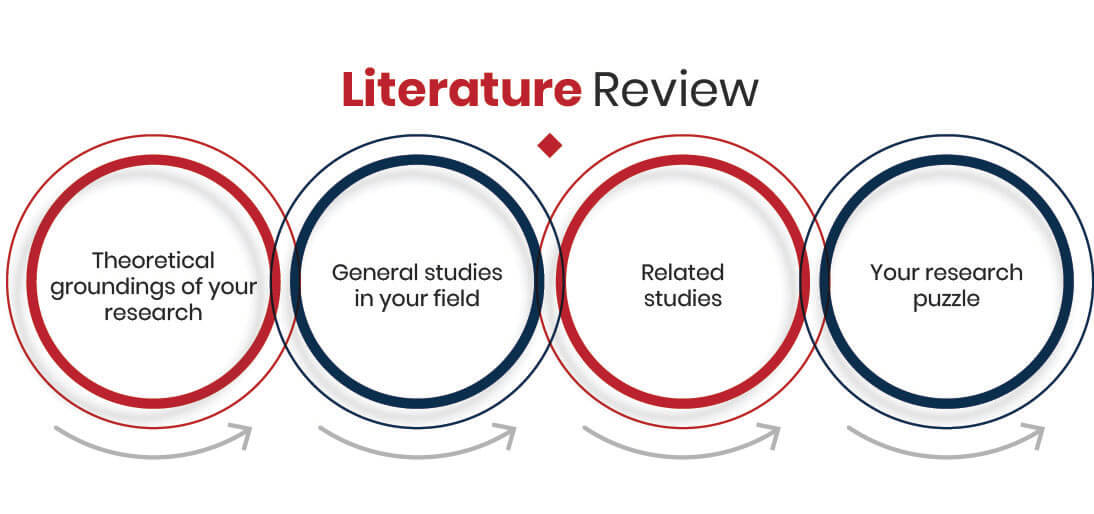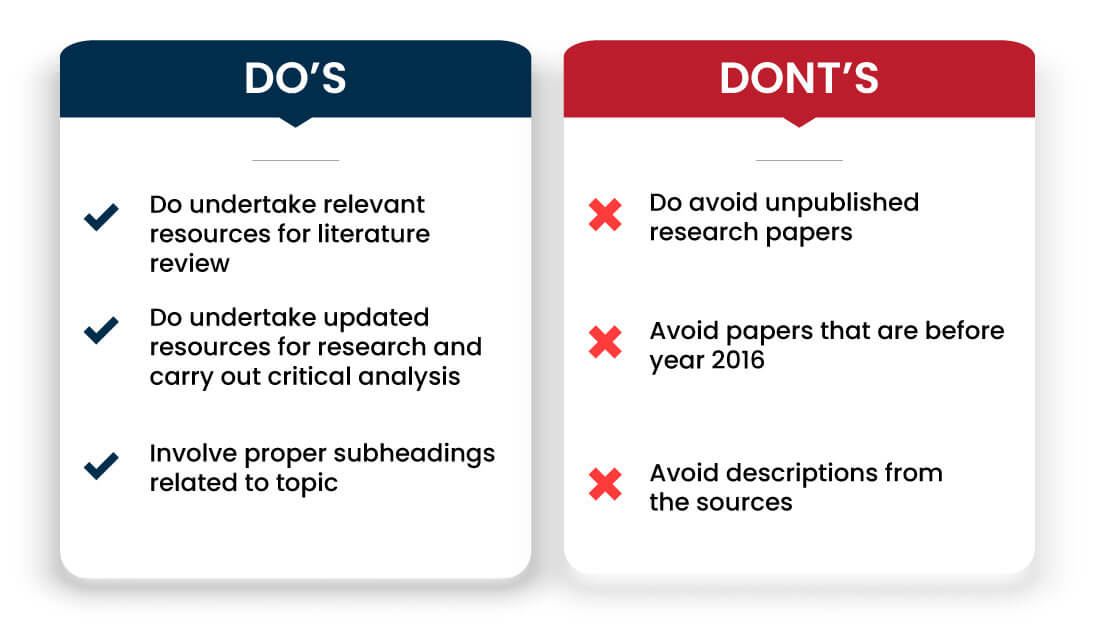What is Chapter 2 Literature Review?
Educational institutes target students to encapsulate a strong survey of dissertations, books, scholarly articles, published materials, and/or conference proceedings. The literature review includes a profound level of research understanding which are addressed in description of the context and critical analysis of a particular issue, topic and/or area of research. However, it has to be noted that literature review should not be confused with the book review that summarises a book as well as has a less structured format. The purpose of a literature review by any author is to provide insights into the work that has been published already. Literature Review is one of the main aspects or backbone of any research as it includes the main context associated with the research topic. It also includes subheadings drawn upon the basis of research objectives.
An example has been mentioned below, showing literature review of a research

Why Literature Review is Important for Dissertation or Research Paper?
A highly formed and developed literature review is embedded to strengthen any thesis or dissertation by evaluating the major problem parameter through academic study. A literature review also includes a prediction of the assumption of the methods, research and results. A productive LR implies the capabilities of the students in the information literacy, language domain and critical writing. Writing an LR is a tricky and critical part of undergraduate life.
Writing a literature review is daunting, there is a procedure in regards to developing a literature review. LR constantly are embezzled with new research which constantly feeds literature review. The main reason is that literature review helps students to grasp knowledge and attain critical assessment of the sources that have surrounded the topic of dissertation. The writing of a literature review is vital as it also helps students to identify gaps in the area of their topic. Also, the LR provides students to establish credibility and acquire professional background. Literature Review is one of the main aspects or backbone of any research as it includes the main context associated with the research topic. It also includes subheadings drawn upon the basis of research objectives. As shown below the essential components of LR includes research topic, relatable studies, general studies and theoretical understanding.

What is the Structure of a Literature Review?
Three headings need to be considered when LR is written. These subheadings are Introduction, Body and Conclusion.
Introduction
The introduction of Literature Review is the first part which includes an overview of the topic. Under this part of LR, the author of the thesis makes sure to provide a quick idea related to the topic of the LR such as organisational pattern or central theme.
Body
This part of the LR pertains to discussions obtained from various sources related to the topic of the research. It includes critical writing aspect by the author of the study. It includes the insights relevant to the topic of thesis.
Conclusion
It includes the useful information drawn effectively by summarising the main points from the literature.
It is important for researchers to make sure that they are incline to address a theory relevant with the literature that has been mentioned associated with the research topic. A well-developed literature review is embedded with explanation of differences and similarities in between the research of different authors. It implies comparison associated with regards to views of several different research studies. Moreover, examination of the research gaps are placed within the research.
How to Write a Literature Review?
Writing a literature review means finding relevant literature (e.g. books, journal articles, etc.), analysing it critically and formulating your conclusions. A proper literature review does not just summarise the material, but examines, organises and critically evaluates the literature so that you can form a reasonable picture of the state of information on the topic. For example, there are some important steps.
Step 1: Search for the right literature
Before you start searching for literature, you need to make a clear characterisation. If you are preparing a literature review for a thesis or examination, you will search for literature that is relevant to your research question(s).
Step 2: Evaluation and selection of material
You will probably not have the opportunity to read all the literature written on the topic without asking. Make sure that the material you use is reliable and that you have read all the important studies and key assumptions in the field.
Step 3: Identify themes, topics and gaps.
To reconcile the topics and structure of your literature review, you need to understand the relationships and connections between the sources you have read carefully. Using the sources and notes you have reviewed, you should look for trends and patterns (principles, strategies, and results), themes, arguments, logical conflicts and inconsistencies, key distributions and gaps.
Step 4: Deciding on the structure of the literature review
There are several ways to structure the appearance of your literature review. Before you start writing, you need to think about your procedures in a way that you do not want to. Depending on the purpose of your literature review, you can combine some of the methods such as Chronological, thematic, etc.
Difference between Literature Review and Annotated Bibliography?
Annotated bibliography
This gives an ordered list of sources that the user can examine in more detail. It usually includes a brief explanation of why each source is reliable and relevant to the topic. In addition, the sources are separated from each other and arranged so that they are not difficult to find.
Each article in the list includes a short section citing a single source using the appropriate citation (usually APA, MLA or Chicago) and a summary illustrating the relevance and importance of the article.
Literature review
The literature review focuses on a particular topic or issue by summarising and explaining the main sources in the field. Different sources are included in the relevant sections of the literature and may be cited more than once. There is a short opening revealing the topic, followed by the subsequent elaboration of the arguments made by different authors, and ending with a summary of the general basis.
Do’s and Don’ts for Literature Review

Checklist for Literature Review
- A detailed research shall be conducted related to the subject matter by acquiring information from books, articles or research papers.
- There shall be sub-headings formed based on research aims and objectives.
- A theoretical framework should be included in the literature review.
- Critical analysis should be performed from different sources for the research topic.



 Whatsapp
Whatsapp Contact
Contact Call
Call Live Chat
Live Chat